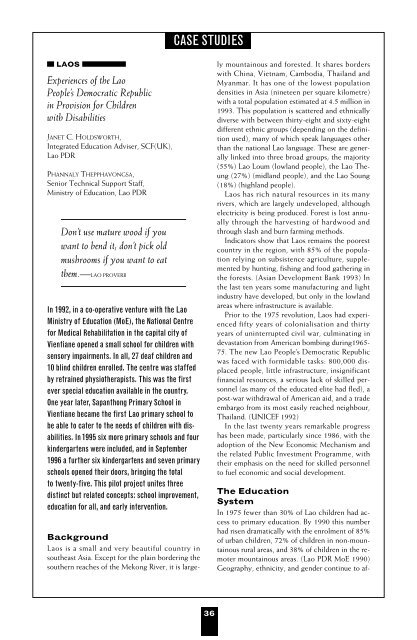Inclusive ECCD: - Consultative Group on Early Childhood Care and ...
Inclusive ECCD: - Consultative Group on Early Childhood Care and ...
Inclusive ECCD: - Consultative Group on Early Childhood Care and ...
You also want an ePaper? Increase the reach of your titles
YUMPU automatically turns print PDFs into web optimized ePapers that Google loves.
CASE STUDIES<br />
LAOSl<br />
Experiences of the Lao<br />
People’s Democratic Republic<br />
in Provisi<strong>on</strong> for Children<br />
with Disabilities<br />
JANET C. HOLDSWORTH,<br />
Integrated Educati<strong>on</strong> Adviser, SCF(UK),<br />
Lao PDR<br />
PHANNALY THEPPHAVONGSA,<br />
Senior Technical Support Staff,<br />
Ministry of Educati<strong>on</strong>, Lao PDR<br />
D<strong>on</strong>’t use mature wood if you<br />
want to bend it; d<strong>on</strong>’t pick old<br />
mushrooms if you want to eat<br />
them.—LAO PROVERB<br />
In 1992, in a co-operative venture with the Lao<br />
Ministry of Educati<strong>on</strong> (MoE), the Nati<strong>on</strong>al Centre<br />
for Medical Rehabilitati<strong>on</strong> in the capital city of<br />
Vientiane opened a small school for children with<br />
sensory impairments. In all, 27 deaf children <strong>and</strong><br />
10 blind children enrolled. The centre was staffed<br />
by retrained physiotherapists. This was the first<br />
ever special educati<strong>on</strong> available in the country.<br />
One year later, Sapanth<strong>on</strong>g Primary School in<br />
Vientiane became the first Lao primary school to<br />
be able to cater to the needs of children with disabilities.<br />
In 1995 six more primary schools <strong>and</strong> four<br />
kindergartens were included, <strong>and</strong> in September<br />
1996 a further six kindergartens <strong>and</strong> seven primary<br />
schools opened their doors, bringing the total<br />
to twenty-five. This pilot project unites three<br />
distinct but related c<strong>on</strong>cepts: school improvement,<br />
educati<strong>on</strong> for all, <strong>and</strong> early interventi<strong>on</strong>.<br />
Background<br />
Laos is a small <strong>and</strong> very beautiful country in<br />
southeast Asia. Except for the plain bordering the<br />
southern reaches of the Mek<strong>on</strong>g River, it is largely<br />
mountainous <strong>and</strong> forested. It shares borders<br />
with China, Vietnam, Cambodia, Thail<strong>and</strong> <strong>and</strong><br />
Myanmar. It has <strong>on</strong>e of the lowest populati<strong>on</strong><br />
densities in Asia (nineteen per square kilometre)<br />
with a total populati<strong>on</strong> estimated at 4.5 milli<strong>on</strong> in<br />
1993. This populati<strong>on</strong> is scattered <strong>and</strong> ethnically<br />
diverse with between thirty-eight <strong>and</strong> sixty-eight<br />
different ethnic groups (depending <strong>on</strong> the definiti<strong>on</strong><br />
used), many of which speak languages other<br />
than the nati<strong>on</strong>al Lao language. These are generally<br />
linked into three broad groups; the majority<br />
(55%) Lao Loum (lowl<strong>and</strong> people), the Lao Theung<br />
(27%) (midl<strong>and</strong> people), <strong>and</strong> the Lao Soung<br />
(18%) (highl<strong>and</strong> people).<br />
Laos has rich natural resources in its many<br />
rivers, which are largely undeveloped, although<br />
electricity is being produced. Forest is lost annually<br />
through the harvesting of hardwood <strong>and</strong><br />
through slash <strong>and</strong> burn farming methods.<br />
Indicators show that Laos remains the poorest<br />
country in the regi<strong>on</strong>, with 85% of the populati<strong>on</strong><br />
relying <strong>on</strong> subsistence agriculture, supplemented<br />
by hunting, fishing <strong>and</strong> food gathering in<br />
the forests. (Asian Development Bank 1993) In<br />
the last ten years some manufacturing <strong>and</strong> light<br />
industry have developed, but <strong>on</strong>ly in the lowl<strong>and</strong><br />
areas where infrastructure is available.<br />
Prior to the 1975 revoluti<strong>on</strong>, Laos had experienced<br />
fifty years of col<strong>on</strong>ialisati<strong>on</strong> <strong>and</strong> thirty<br />
years of uninterrupted civil war, culminating in<br />
devastati<strong>on</strong> from American bombing during1965-<br />
75. The new Lao People’s Democratic Republic<br />
was faced with formidable tasks: 800,000 displaced<br />
people, little infrastructure, insignificant<br />
financial resources, a serious lack of skilled pers<strong>on</strong>nel<br />
(as many of the educated elite had fled), a<br />
post-war withdrawal of American aid, <strong>and</strong> a trade<br />
embargo from its most easily reached neighbour,<br />
Thail<strong>and</strong>. (UNICEF 1992)<br />
In the last twenty years remarkable progress<br />
has been made, particularly since 1986, with the<br />
adopti<strong>on</strong> of the New Ec<strong>on</strong>omic Mechanism <strong>and</strong><br />
the related Public Investment Programme, with<br />
their emphasis <strong>on</strong> the need for skilled pers<strong>on</strong>nel<br />
to fuel ec<strong>on</strong>omic <strong>and</strong> social development.<br />
The Educati<strong>on</strong><br />
System<br />
In 1975 fewer than 30% of Lao children had access<br />
to primary educati<strong>on</strong>. By 1990 this number<br />
had risen dramatically with the enrolment of 85%<br />
of urban children, 72% of children in n<strong>on</strong>-mountainous<br />
rural areas, <strong>and</strong> 38% of children in the remoter<br />
mountainous areas. (Lao PDR MoE 1990)<br />
Geography, ethnicity, <strong>and</strong> gender c<strong>on</strong>tinue to af-<br />
36
















